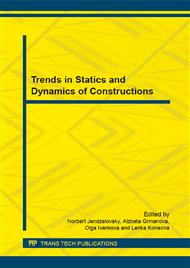p.200
p.206
p.212
p.218
p.225
p.229
p.235
p.241
p.245
Comparison of Natural Frequencies of Hollow Core Slabs
Abstract:
This article is devoted to the calculation of natural frequencies of concrete slabs. Natural frequencies of a solid slab and a hollow core slab have been compared. Solid slab and lightened slab with reduced self-weight and stiffness have been modeled using FEM software ANSYS as 2D model using shell elements. Third model was made from 3D elements as a hollow core slab. Two types of boundary conditions have been considered: a simply supported slab and a clamped slab. The changes in natural frequencies according to aspect ratio of the slab were compared, too. Numerical methods have been compared with simplified method of calculation of natural frequency of slabs, as e.g. an equivalent plate approach; approximation presented by Hearmon and compilation of formulas by Bachmann.
Info:
Periodical:
Pages:
225-228
Citation:
Online since:
June 2015
Price:
Сopyright:
© 2015 Trans Tech Publications Ltd. All Rights Reserved
Share:
Citation:


